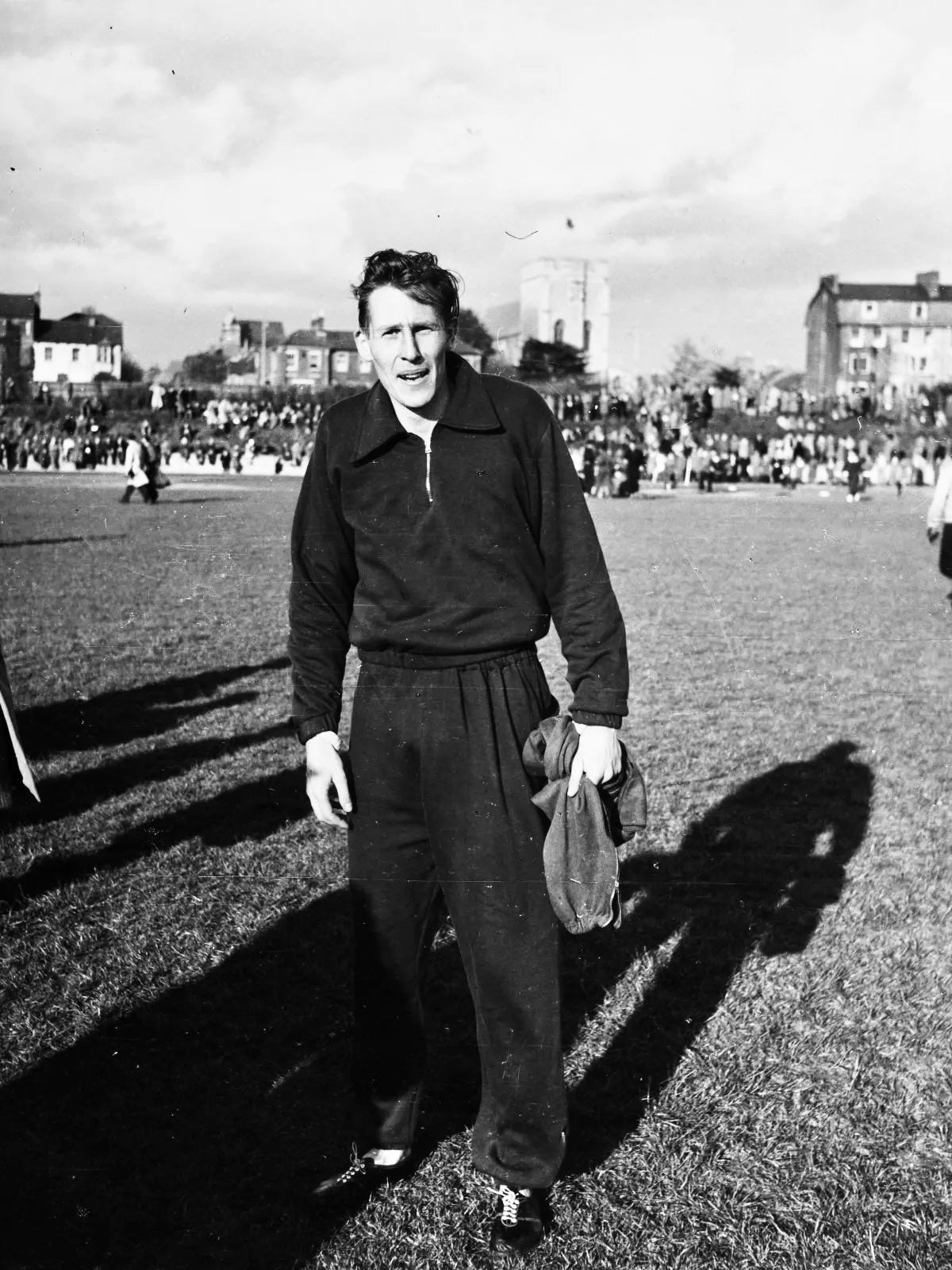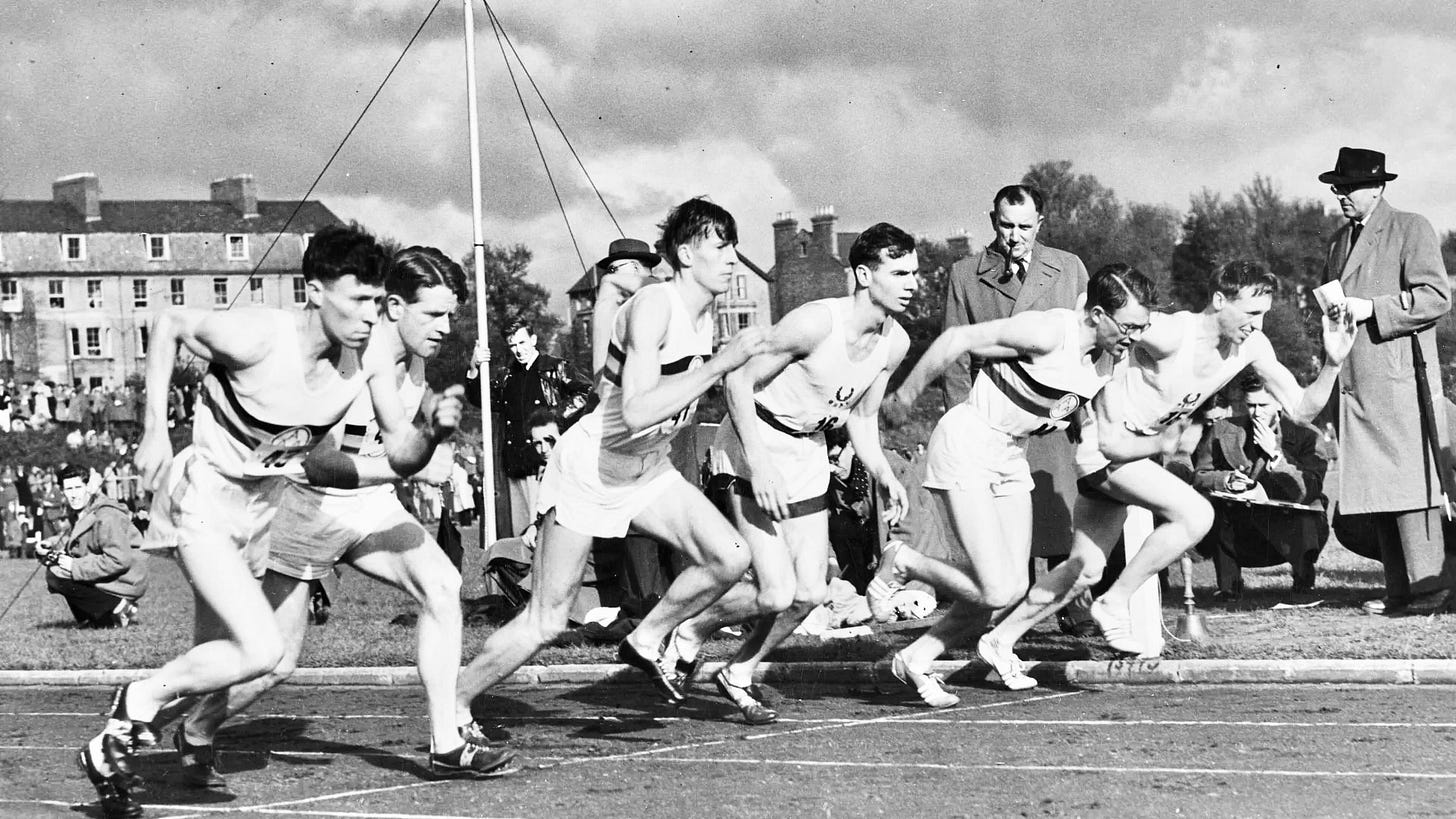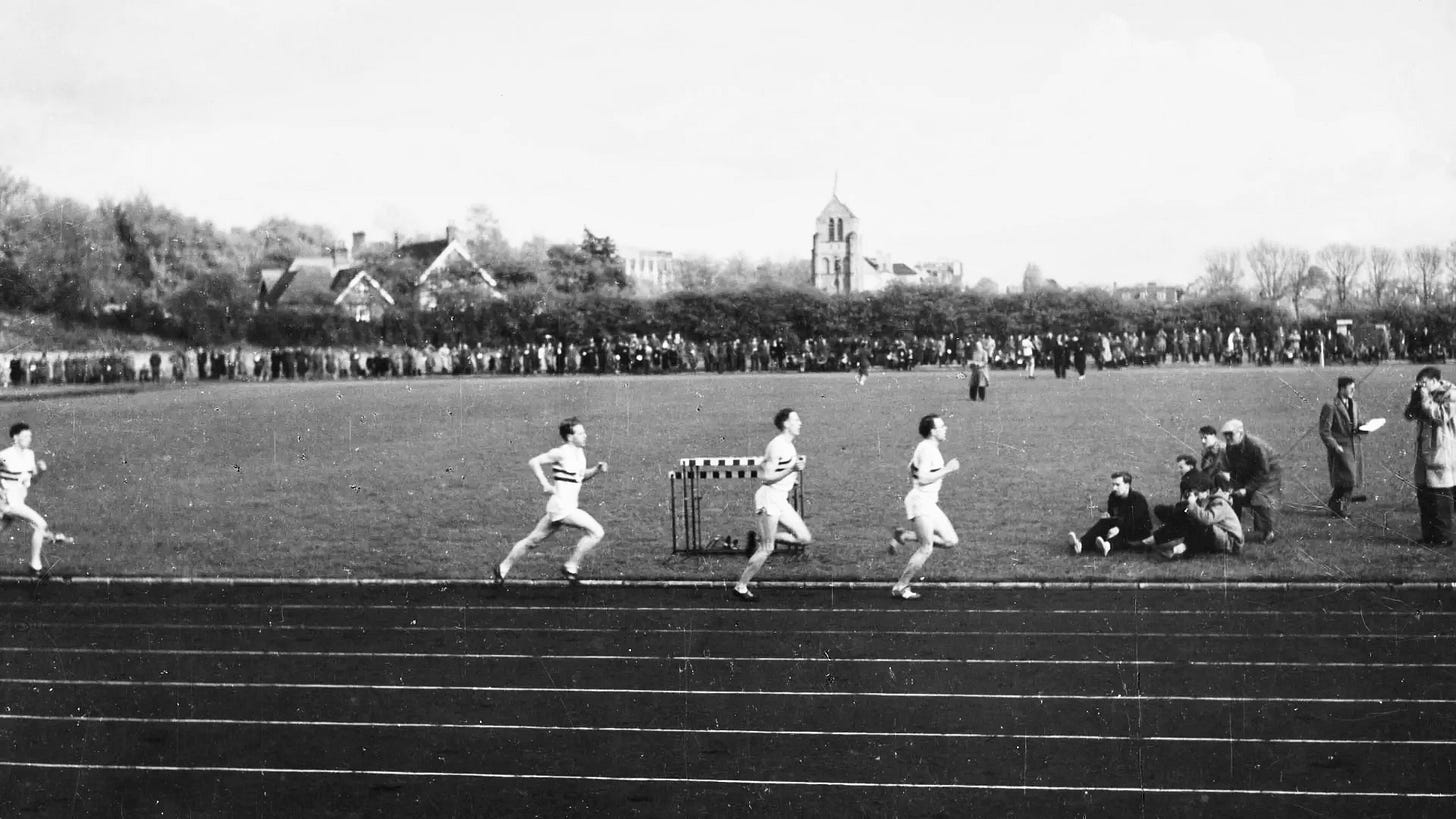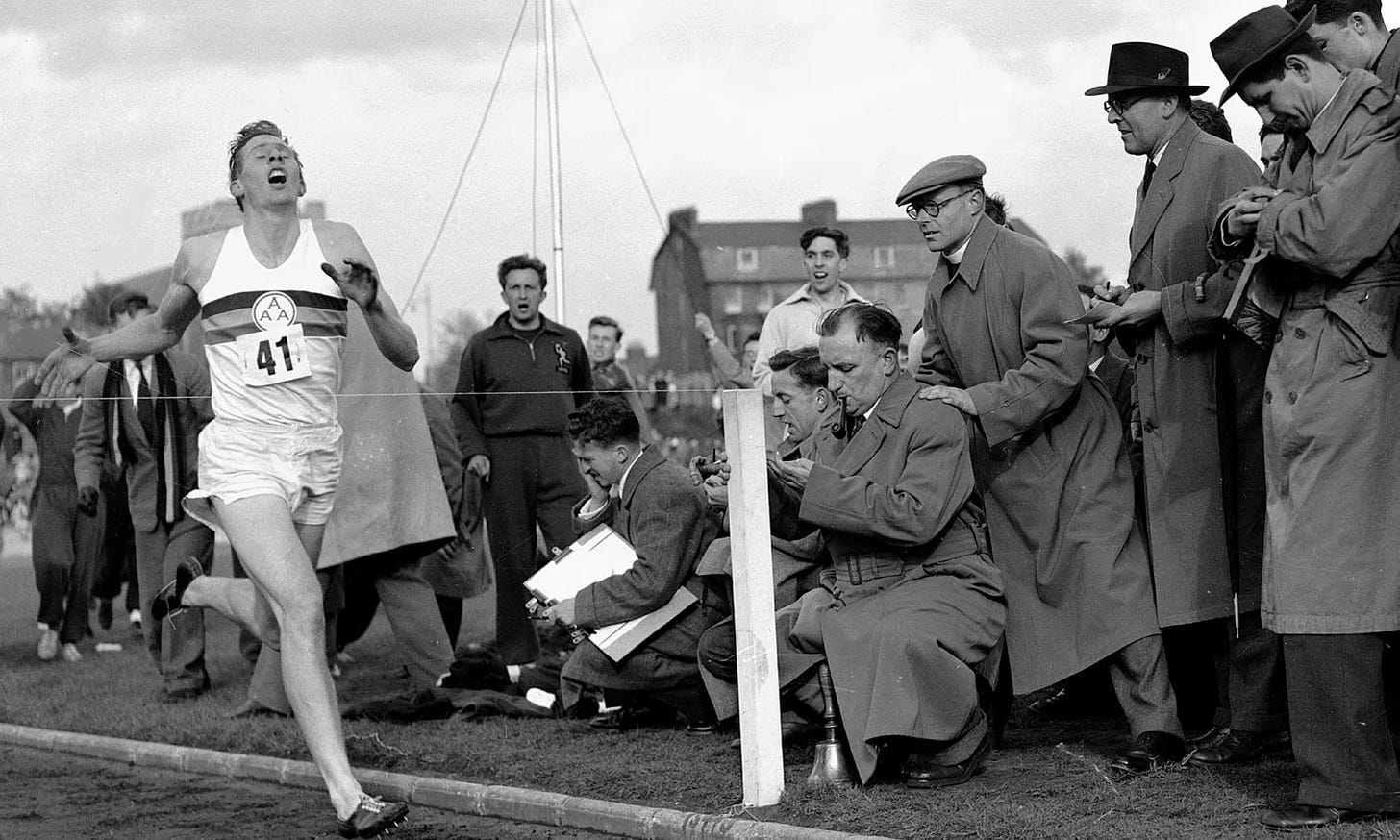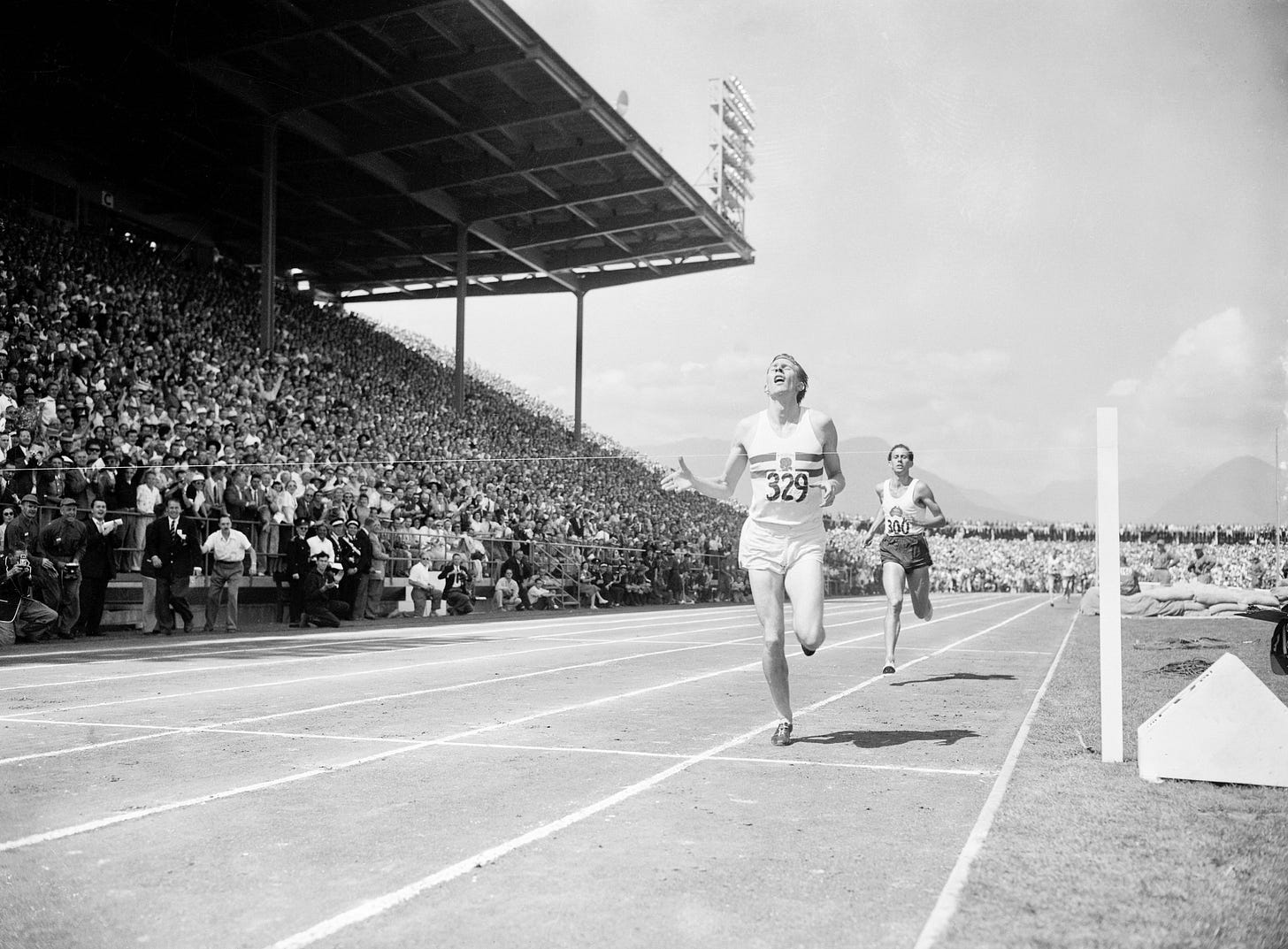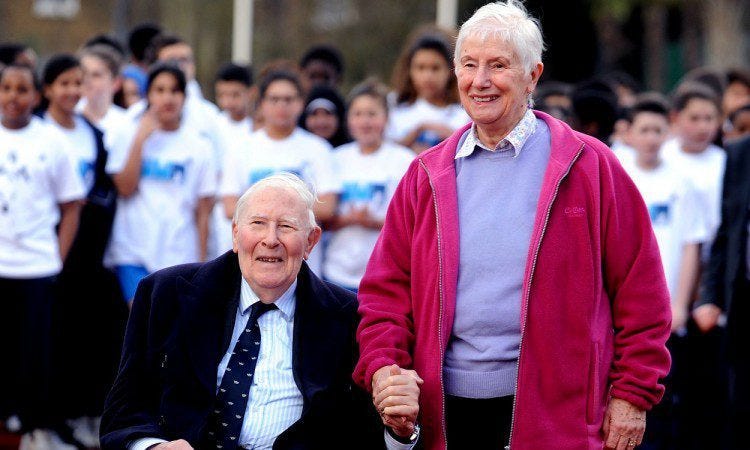Roger Bannister Shortly After Becoming the First Man to Run a Mile in Under Four Minutes
Credit: Oxford Mail
How many readers know the names Derek Ibbotson, Derek Johnson or Gordon Pirie? Between them, these men have eight major medals and half-a-dozen world records. Roger Bannister’s career saw two medals and world bests.
Margins of success can be very small, and but for six-tenths of a second, it is quite possible that Bannister would have found himself in the same sporting semi-obscurity as the first three - just a very handy British runner from the fifties who had won the odd medal, and whose career now exists only in the deep vaults of Pathé News.
Yet, at just after 6.00p.m. on Saturday 6th May 1954, the 25yr old junior doctor’s final stride of a four-lap race at Iffley Road, Oxford earned Bannister sporting immortality.
Proper sporting immortality - the kind of which there is absolutely no point including in sports quizzes. Whilst his name does not resonate globally like Ali, Pele or Jordan, it still resides alongside other sporting gods whose recognition can rest on their last name - Sobers, Spitz, Nicklaus, Merckx, Borg. This is actually quite remarkable for Bannister’s career was short - essentially it distills into summer 1954 - and unlike the aforementioned he did not accomplish copious victories and records over many years. Like a soldier being awarded the Victoria Cross, Bannister’s fame rested on just a single outstanding deed.
Bannister’s sporting immortality was born of a running race at an athletics meeting between Oxford University and the Amateur Athletics Association on a blustery day in May 1954, on a cinder track in middle England before two or three thousand people.
Of a lower middle-class background, Bannister was gifted both intellectually and physically. At 16yrs of age, he had been offered a place at St John’s College, Cambridge University, but declined and waited. Then aged 17yrs, he went up Exeter College, Oxford in 1946 to study medicine. He was tall with languid limbs that were not too heavily muscled, and had a good, long, smooth stride and natural speed. He was perfect for middle-distance running. However, there may have been questions about his strength and stamina, for having been 10yrs old when the second war started, his body had matured during a long, long period of food rationing. Indeed, the meat ration which began on 11th March 1940 was still in effect at the time of the ‘big race’. It is probably not a coincidence that, internationally, for a number of decades, British sports teams and individuals only achieved modest success.
Bannister had had shone in school cross-country competitions, but he only began to take running seriously at Oxford. His talent was plain to see and quick to develop. In 1947, he won the Varsity mile - in 4:30 - before turning 18yrs, and was asked if he wished to be considered for the 1948 Olympics. He declined considering himself nowhere near ready for that level. Instead, he poured his energies into his studies and his university athletics club - becoming president in 1949 - and made startling progress during his few years of ‘serious’ athletics.
Bannister in Oxford University Colours at the British Athletic Championships at White City - 1949
If growing up during the extended food rationing stacked the odds against him becoming an international standard runner, then Bannister’s training regime lengthened them even further. First and foremost, he was at Oxford to study and to lay the foundations of a career that would improve his prospects. His studies came first, and his sparse training regime was constructed around lectures.
Nevertheless, his natural talent took him to the very top of British middle-distance running, and he was strongly tipped to win a medal at the 1952 Helsinki Olympics. Later in life he confessed that had he won gold, he would have retired to concentrate on his career. However, the ‘small margin’ principle came into play, and he failed by sixth-tenths of a second to win a medal in the 1500m. In his dismay at coming fourth - albeit in a British record time - Bannister resolved to be the one to ‘break the barrier’. However, time was a finite resource, because he had decided - but not revealed - that come what may, he would definitely step away after becoming a fully qualified doctor. If he wanted to achieve something great it would have to be done by summer 1954. He dedicated himself so completely that he ended a three year relationship with his American fiancé.
Time was also limited because two other men, an Australian John Landy and an American Wes Santee1 were also going after the four minute landmark. It might never have happened though. Post-war, the world mile record stood at 4:01.4. Two Swedes, Gunder Hāgg2 and Arne Andersson had exchanged it six times over the war-time summers in their neutral homeland, and it was highly likely that one, or both of them, would have gone under four minutes before the end of the 1940s3. Regrettably, in 1946, the two rivals and great friends were banned from competition for breaching the rules of amateurism.
In 1953, Bannister reduced his mile PB from 1952’s 4:07.8 to an official 4:03.6, and an unratified 4:02. On 1st August 1953 he became part owner of a world record, when Bill Nankeville, Don Seaman and Chris Chataway a new 4 x 1 mile relay record - 16:41.0 - was established.
By the end of the year he had acquired a coach, Franz Stampfl4, to help implement his plan to break the record in 1954. Stampfl altered his training regime, but it was still one that was based on quality and not quantity as his duties as a student doctor at St Mary’s Hospital, London took precedence.
Stampfl’s programme of interval running - usually in Paddington Park - had to fit in with Bannister’s busy schedule at the hospital. Always less than an hour and usually no more than 40-mins. Bannister was phlegmatic about this, “Yes, training was short, but it was very hard. Look the race is only four minutes, so what good is there in running ten miles?”
The cooperation of two of his GB team-mates, Chris Brasher and Chris Chataway was crucial to the plan, and no doubt periodically Bannister would train with them to perfect their race tactics. One suspects that this was done quite furtively, because in those days, the principles of amateurism in athletics were pure and unyieldingly strict, success had to earned by the unpaid effects of the individual who competed only for honour. Pace-making was very much frowned upon. In June 1953 in Surrey, Bannister had run a British record time of 4:02 with two pace-makers, Australian Don Macmillan who dropped out, and Chris Brasher ran so slowly he allowed himself to be lapped thus sparing his energy to lead Bannister around his final lap at full tilt.
It was a clumsy scheme which saw the race organisers refuse to ratify Bannister’s time, relating that it as ‘not in the interests of British athletics’ - which Bannister later stated he was very glad about. The authorities emphasised that any pace-makers involved had to be ‘honest competitors’ and must finish the race, otherwise any record achieved would not be officially endorsed. Herein lies a potential controversy in respect of Bannister’s record - of which more below.
The ‘holy grail’ of running a mile in under four minutes was thought to be physically impossible, physicians had opined that anyone attempting it was risking their life. Neither Bannister nor Landy believed this though - probably no serious athlete did - but in pessimistic post-war British it was a truism and this belief was aired commonly, thereby assigning mythical status to the feat.
In spring 1954, news from Australia related that John Landy had failed to break the barrier during their summer season, but was headed for Europe intending to do so at one of the Scandinavian meetings. Bannister had to strike before Landy’s arrival, and the Oxford vs AAAs meet was his first opportunity.
As a contest between men, the race was inconsequential, what mattered was Roger Bannister’s contest with an object that had three hands and no feet - a stopwatch.
On the morning of 6th May, Bannister ate a bowl of porridge and went into the St Mary’s Hospital laboratory and sharped the spikes of his running shoes before heading off to the station to meet Stampfl. Arriving at Oxford at lunchtime, they were picked up by a friend who took them to his home for some lunch - ham salad apparently. It was a disappointingly damp and blustery day and Bannister was not sure that he would make the attempt.
However, it wasn’t that awful a day because a mile-and-a-half up the road at The Parks, they were playing cricket. Skippered by Colin Cowdrey and with another future England captain Mike Smith alongside him, Oxford University were in the middle of a three-day game against Yorkshire. The visitors had brought a full team, including: Len Hutton, Norman Yardley, Johnny Wardle, Brian Close, Ray Illingworth and Fred Trueman - who had skittled Oxford’s first innings on that damp Saturday with figures of 10-7-8-5.
Strampfl told the reticent Bannister, “If you have the opportunity - not a perfect opportunity - and you don't take it, you may never have another chance”. The race was scheduled for 6.00pm and Bannister moped around edgily at his friend’s house until about 4.30pm when he went down to the track. At around 5.20p.m. he saw that the flag atop a nearby church had draped down parallel its pole - the wind had dropped, and Bannister’s spirits were raised. There would be an attempt.
Tom Hulatt - Chris Chataway - Roger Bannister - George Dole - Chris Brasher - Alan Gordon
Credit: Getty Images
Brasher made a false start, which irked Bannister a little because he was concerned that the wind might pick up at any time. They got away cleanly the second time, the wind remained calm and so did Brasher. He did his job perfectly and would complete the first half of the race in 1:58; but at one point clearly feeling very comfortable both physically and mentally Bannister thought it was too slow and urged Brasher to press on - a plea he ignored.
On the second lap Bannister was still a little angsty, but he heard a voice from the crowd urging him to ‘Relax’ - it later transpired to have been Stampfl’s - and it had the desired effect for Bannister began to run as if in a trance.
The plan was for Chataway to take over the pace-setting with about 700yds to go, which he would do. As the third lap progressed the crowd began to appreciate that there was a chance that they were witnessing athletic history and the bowl of Iffley Road rippled with constant applause as if for the monarch.
Lap 2 - Brasher - Bannister - Chataway - Hulatt
Credit: Unknown
As the final lap began the timekeepers indicated that Bannister would have to run it in 59 seconds, and as Chataway pressed on the applause became less controlled as the crowd became more animated. Their mood became more excitable still as with 250yds to go, Chataway’s efforts declined and Bannister struck for home. He widened his stride - he would have about a hundred more to make - and with his limbs pumping, head slightly back and mouth open he powered home, broke the tape and collapsed into a forest of long overcoats.
The announcement was made by Bannister’s good friend Norris McWhirter5 who had been commentating for the BBC alongside 1924 Olympic sprint champion Harold Abrahams; as is now well-known the when McWhirter announced the time, the crowd erupted at the word ‘three’ and did not hear the rest.
Bannister Crosses the Line - the Man with the Clipboard is Bannister’s ‘Ham Salad’ Friend - He is Weeping
Credit: Oxford Mail
The race finished with Bannister’s time recorded as 3:59.4, then Chataway6 second in 4:07.2, third was Tom Hulatt7 in 4:16, then Alan Gordon8 in 4:18 and George Dole9, an American Rhodes Scholar came in fifth in 4:25 - although he wrote home telling that he was last.
So where was Chris Brasher10?
There is no doubt that his first 900yds had taken much out of him, and he was reduced to a jog at the rear of the field. He would be coming home in well over 4:30 - but did he make it all the way to the line? The question arises not because Brasher stopped running but because the track was invaded by throngs of delirious well-wishers who blocked his way. The race officials had lost control as the spectators invaded the track in the manner of a 1970s one-day cricket final.
With luck, Brasher did manage to force his way through the crowd and cross the line. If he didn’t then - not that it matters now - technically the legitimacy of Bannister’s record was put in doubt for it was essential for pace-maker Chris Brasher to have completed the race.
In an immediate post-race television interview, Bannister thanked his two friends for, “….helping to make some of the running early on……their presence gave me the extra spur to go on”, but he was very careful not to use the word ‘pace-maker’.
Bannister and his chums disappeared off to London to celebrate - their lives would never be the same. What they had done was political PR of the purest quality; within days they would meet Churchill at Downing St., and then the Foreign Office packed the record-holder off to New York as a ‘good will ambassador’. Bannister was also awarded a CBE in the Queen’s Birthday Honours of 1955.
However, just a few weeks later in Turku, Finland on 21st June, John Landy11 took his world record with a time of 3:57.9; but a reckoning, a show-down, a head-to-head was in the offing.
The British Empire & Commonwealth Games took place in Vancouver in early-August. On the final day of the games, the 30,000 crowd was treated to the ‘Miracle Mile’, a race between the world’s two best middle-distance racers. Probably 100 million people listened to the radio commentary, with millions more with TVs tuning in too.
Very much aware of Bannister’s tremendous finishing speed, Landy had concluded that he had to win it from the front and took the lead on the first lap. At one point he was some 15yds ahead, but Bannister had reeled him by the end of the third lap. At the top of the final bend, sitting behind Landy, Bannister made his move. Landy glanced over his inside shoulder12 just as Bannister was overtaking on his right. No doubt it cost Landy a second or two, but it did not affect the result, for there was no stopping Bannister, he powered to the finish line and won by about 3yds. This was the first ever mile race in which two men broke the four-minute mark.
Roger Bannister Beats John Landy at Vancouver - 7th August 1954
Credit: Getty Images
Three weeks later at the European Athletics Championship in Bern, Switzerland, Roger Bannister won gold in the 1500m in 3:43.8 - which was a championship record. He was in the form of his life, but he would not race again.
On 9th December, whilst speaking at a dinner hosted by the Sportswriter’s Association Bannister said, "Now that I am taking up a hospital appointment, I shall have to give up international athletics. I shall not have sufficient time to put up a first-class performance. There would be little satisfaction for me in a second-rate performance, and it would be wrong to give one when representing my country."
At Christmas, the BBC inaugurated its ‘Television Sports Personality of the Year’ award. Public votes were cast not long after Chris Chataway had defeated Vladimir Kuts live on TV in front of tens of thousands, and he duly won the award in front of Bannister and a female show-jumper called Pat Smyth - completely neglecting ground-breaking achievement that had taken place in Birmingham on 29th May.
Bannister had retired from top flight athletics, but continued to run almost every day until a traffic accident in his fifties prevented it. As he had always intended, he went on to build a career in medicine, specializing in neurology. After completing his National Service as a doctor in Aden, he would become Director of the National Hospital for Nervous Diseases, Chairman of the British Sports Council, President of the International Council for Sport and Recreation and Master of Pembroke College, Oxford - with a knighthood awarded in 1975. He passed away just before his 89th birthday in March 2018.
Bannister’s record was one of a series of events in the early-1950s that - after the intense post-war austerity - helped Britons recover a cheerful, more optimistic equilibrium. Yet it was not the only mile record that was broken that spring, indeed, that month. Diane Leather13 a Birchfield Harrier from south Staffordshire decided to attempt to break the 5-min barrier for the women’s mile on 26th May at Birmingham. This was an equally significant barrier, and there was strong media interest. Despite running from the without pace-makers Learther fractionally missed - 5:00.2 - the mark. However, she would earn glory three days later at the same venue for the same team in the Midland Counties Championship. The conditions were poor, but having won the 880yd in a British record time (2:14.1) forty-five later she decided to ‘have another pop’ at the mile. Again, running from the front without assistance she clocked 4:59.6 and the women’s barrier was broken too.
Within 18 months, Leather would reduce the record down to 4:45.0 - though at that time, women’s records were known as ‘world bests’, not being recorded officially until 1967. This was an era when the longest distance for female Olympians was 200m14. Whilst she may have been lauded contemporaneously, Diane Leather received scarcely any lasting fame outside athletic circles. She did not receive a CBE in 1955, nor a BBC Sports Personality award and nobody knows her name, yet without question she was one of Britain’s greatest female runners. She married in 1959 and her career petered out. She moved to Cornwall and became a tireless social worker - who never mentioned her athletics career, not even to her children. She passed on aged 85yrs in September 2018. Just before she died her 20yr old great-niece Ellie Leather ran her first mile in under five minutes - and has since surpassed the great woman’s times as she continues to build her own career.
Sir Roger Bannister and Diane (Leather) Charles in London - February 2014
Credit: PA Images/Anthony Devlin
To this day, no female has broken the four-minute barrier for the mile. Since July 2023, the record stands at 4:07.64, set by Kenya’s Faith Kipyegon, winner of multiple 1500m Olympic world championship golds. However, it is believed that next month, the 31yr old with nothing else to prove, will make an attempt on the barrier on Thursday 26th June at the Stade Charléty in Paris. She is wished well, but is it not a great shame that Iffley Road, Oxford will not be the venue?




